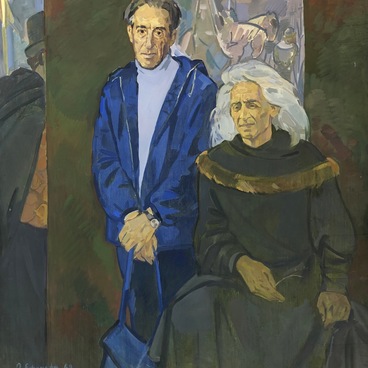Khasolt Akiev painted Carpet Maker in the 1970’s depicting an elderly woman with an ornamental carpet behind her. A ball of yarn and a wool card are placed in the background. Next to the carpet a white shawl is seen stretched on the loom – a piece of work yet to be completed. All these attributes point to her profession.
The carpet maker is portrayed in a static pose taking a short rest, looking pensively into the distance. Her hard hands speak of years of enduring work. According to art expert Khava Akieva, the subject is the artist’s mother.
Khasolt Akiev’s works continue the traditions of the realistic school. His major themes are the diverse natural world of mountainous Ingushetia and emotionally truthful portrayals of his contemporaries. The paintings – mostly landscapes and portraits – expressed his love for his native country and deep respect for people.
The woman worker was a typical subject of Soviet-style painting. Artists tended to glorify physical labor and the working class: apart from military men, scientists and actors, many paintings featured industrial workers, women employed at garment factories, and harvest pickers.
Khasolt Akiev was well known in Ingushetia as a scholar in Caucasus history, poet and artist. After graduating from the History Department of the Chechen-Ingush State Pedagogics Institute he dedicated his time to research and teaching. In 1989 he joined the Institute faculty as senior lecturer and was involved in establishing the department of graphic arts. He also headed the chair of aesthetic education. Despite his busy schedule as researcher, Akiev continued painting. Even in the most difficult years, in his wife’s words, ‘the last kopeck was spent on cardboard, oil paints and brush’.
After the onset of the 1994 military action in Grozny Akiev moved his family to Ingushetia, where he was put in charge of the Chakha Akhriev Research Institute of the Humanities. Later on, and until his last days, he was a history chair associate professor at the Ingush State University. Throughout his life Akiev combined the careers of researcher and artist.
The carpet maker is portrayed in a static pose taking a short rest, looking pensively into the distance. Her hard hands speak of years of enduring work. According to art expert Khava Akieva, the subject is the artist’s mother.
Khasolt Akiev’s works continue the traditions of the realistic school. His major themes are the diverse natural world of mountainous Ingushetia and emotionally truthful portrayals of his contemporaries. The paintings – mostly landscapes and portraits – expressed his love for his native country and deep respect for people.
The woman worker was a typical subject of Soviet-style painting. Artists tended to glorify physical labor and the working class: apart from military men, scientists and actors, many paintings featured industrial workers, women employed at garment factories, and harvest pickers.
Khasolt Akiev was well known in Ingushetia as a scholar in Caucasus history, poet and artist. After graduating from the History Department of the Chechen-Ingush State Pedagogics Institute he dedicated his time to research and teaching. In 1989 he joined the Institute faculty as senior lecturer and was involved in establishing the department of graphic arts. He also headed the chair of aesthetic education. Despite his busy schedule as researcher, Akiev continued painting. Even in the most difficult years, in his wife’s words, ‘the last kopeck was spent on cardboard, oil paints and brush’.
After the onset of the 1994 military action in Grozny Akiev moved his family to Ingushetia, where he was put in charge of the Chakha Akhriev Research Institute of the Humanities. Later on, and until his last days, he was a history chair associate professor at the Ingush State University. Throughout his life Akiev combined the careers of researcher and artist.




